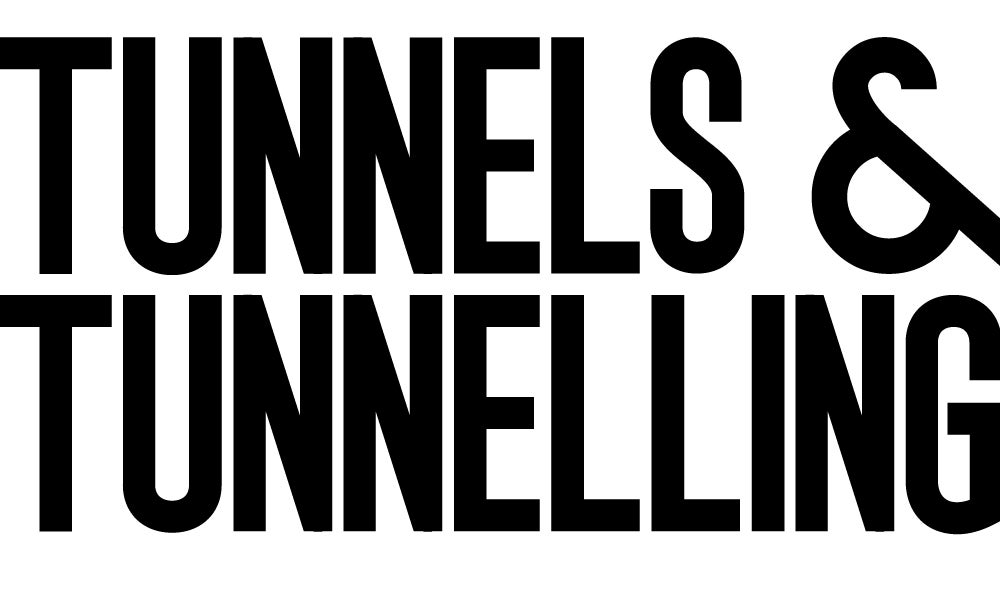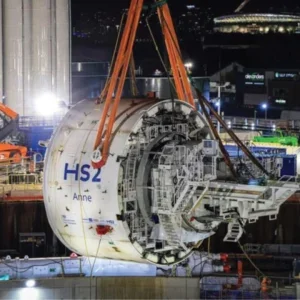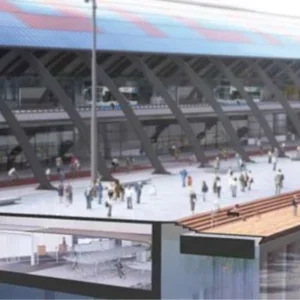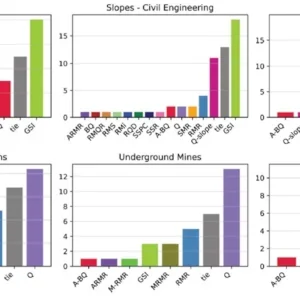The London Tunnels section of the Channel Tunnel Rail Link comprises 17.5km of twin bored tunnels of 7.15m i.d. The tunnels (crown) will run at an average depth of about 30m below ground surface and approximately 11km will be constructed in permeable and saturated strata comprising the Upnor Formation and the Thanet Sand. There are five deep ventilation shafts and 26 cross passages. Three of the shafts and 17 cross passages will be sited in or adjacent to water-bearing saturated strata. And, not least, there is also the Stratford box, a 1,070m long open structure 50m wide and 22m deep.
An assessment carried out by Rail Link Engineering (RLE) early on in the project concluded that achieving dewatered conditions along the London Tunnels alignment would reduce risks and improve health and safety. Benefits would be gained in the construction of shafts, cross passages, sumps, approach structures and the running tunnels themselves. Reduced water pressures are likely to reduce the cost and time for construction, and also lower the risk of failure of the construction method and, thereby, reduce the risk to the programme.
Reducing the groundwater pressures will help secure Health and Safety Executive approval of the tunnel construction arrangements where man entry may be required. Complete dewatering, from either the surface or from within the constructed tunnel, is currently the preferred method of ground treatment for cross passage construction. It is hoped this would avoid the need for ground freezing, which is expensive and complicated.
The dewatering activities carried out for construction of vent shafts and stations on the Jubilee Line Extension were relevant to CTRL plans because the hydrogeological conditions are extremely similar at the two projects’ locations. The influence of the dewatering at JLE sites, which reached maximum output in late 1995, extended east-north-eastwards from Canada Water station for approximately 10km. This regional dewatering was achieved as a by-product of shaft dewatering and brought considerable, although unplanned, benefits for construction of the JLE tunnels.
The value of these benefits was recognised and taken account of at the outset of the CTRL project, and the dewatering was designed and planned to achieve maximum advantage for tunnel and cross-passage construction.
Scheme design and planning
The starting point for developing a comprehensive dewatering scheme for the CTRL tunnels was the need to construct both the Stratford box and the vent shafts for the London Tunnels under dewatered conditions. Major dewatering was therefore going to take place at five points (three vent shafts and at either end of the Stratford box) along the 11km of the tunnel drive situated within the lower aquifer.
It was a logical step for the CTRL designers to consider extending the dewatering into the sections of tunnel between these five pumping centres.
RLE carried out large-scale pumping trials during the pre-tender period to investigate the hydrogeological conditions at strategic locations along the tunnels alignment. It developed a sophisticated computer model of the aquifer system, which was used to design and plan a comprehensive deep-well dewatering scheme. Wellsites were identified, a provisional pumping programme produced, and key Environment Agency consents were obtained. Wellsite acquisition was set in train. The results of the trials and the detailed planning and computer modelling information were provided to tenderers.
Geology and groundwater conditions
The western end of the tunnels lie in a part of central London where groundwater levels are severely depressed as a result of historic abstraction. Further east, groundwater levels are fully recovered and the piezometric level in the lower aquifer is close to ground surface.
For two-thirds of the distance along the tunnel alignment from the London (Gifford Street) portal to Stratford the water table is below the tunnel invert. Thereafter, the water table is above the tunnel invert, initially only by a few metres, but rising to 15m at Stratford. For most of the next 6km eastwards to Barking the submergence is between 20m and 30m and, without dewatering, tunnelling would have to be carried out under pressures of 2-3 bar.
The Thanet Sand, in which the tunnels will be constructed, is part of the Lower Aquifer and is in hydraulic continuity with the Chalk. The permeability of both units is moderate to high (10-5m/d to 10-4m/d), while the storage capacity of the Thanet Sand in particular is high. These properties make the Thanet Sand-Chalk system a very productive aquifer for water supply purposes. They are also, however, the reason why high abstraction rates are necessary to achieve significant groundwater lowering for construction dewatering, both initially when water is drawn from storage and later when drawdown has been achieved and water is derived predominantly from horizontal inflow to the area of abstraction.
Dewatering by pumping directly from the Thanet Sand was not considered practicable for the general tunnel dewatering, or as the principal means of groundwater lowering for construction of the vent shafts. Wells constructed in this fine sand typically have low yields (1-3litre/s) and are prone to clogging and sand entry, as well as being difficult to construct. Instead, the method adopted for general tunnel dewatering on CTRL was to install wells into the Chalk, and case off the overlying Thanet Sand. Dewatering of the Thanet Sand would be achieved by pumping from the Chalk to underdrain the overlying strata. Well yields in the Chalk are typically 15-20litre/s, and well construction is relatively straightforward. This was the approach used successfully on the JLE project, and it is also how the permanent dewatering scheme for the Stratford box has been designed (see below).
Pumping trials and modelling
Hydrogeological conditions vary at different points along the tunnel alignment. While large-scale dewatering was clearly feasible in principle, RLE designers recognised the importance of proving its effectiveness at specific locations. In addition, the pumping requirements to achieve a particular degree of water level lowering depend on the local hydrogeology, and planning of the scheme must take account of local variations in, for example, confined/unconfined aquifer conditions.
In locations where the aquifer is initially confined, and a piezometric surface exists within the overlying clay layer, the drawdown in response to pumping is rapid at first. After some days or weeks, the rate of lowering slows as the water level reaches the top of the aquifer layer and conditions become unconfined.
Accordingly, trial dewatering wells were drilled and 90-day pumping tests were carried out by RLE at three key locations on the alignment. The results were analysed and used to refine the computer model of the aquifer system. The model covers an area 10km north-south, by 21km west-east. The Graham Road ventilation shaft defines the western boundary, and the Ripple Lane tunnel portal and the Dagenham Pumping Station borehole mark the eastern edge of the model. The River Thames runs along the southern edge of the model area.
Initial steady-state model development and calibration was based on a four-layer model, representing the upper (alluvial) aquifer, the variable aquitard of the London Clay and/or Woolwich and Reading Beds, the Basal Sands, and the underlying Chalk. Later simplification for transient model development involved removing the upper two layers and using recharge to simulate aquitard leakage, leaving a two-layer model representing the Sands and Chalk of the lower aquifer.
The results of the modelling showed that pumping needed to begin as much as 18 months ahead of the passage of the TBMs. Contractors therefore began implementing the dewatering scheme immediately after start of construction activities in July 2001.
Well drilling is now well advanced on Contracts 220 and 240, and preparatory work is under way on Contract 250. Pumping has already started at key locations, and drawdown is being carefully monitored.
When complete the dewatering scheme (all Area 200 contracts) will comprise 22 wellsites (including three vent shaft sites and Stratford), with 39 wells pumping at a combined rate of 700litre/s (60Mlitres/day). The majority of the wellsites are on land leased by the project close to the alignment. Where it was impossible to find or acquire suitable sites, wells were drilled in the street.
Wells are below ground level in all cases, with the headworks and connections housed in a covered chamber. A number of existing water supply wells have been incorporated into the network by arrangement with the owners, notably the East Ham Pumping Station. This is a standby public water supply well owned by Thames Water, which has been re-commissioned and is being pumped for Contracts 240 and 250.
Water disposal
The sewerage system in the area of London through which the CTRL London Tunnels run comprises a large proportion of combined sewers, with foul and storm flows carried in a single pipe. This means that all sewage flow is routed through the sewage treatment works, and in consequence trade effluent charges are levied on all discharges to sewer.
The system is also very old and leakage of shallow groundwater into the pipes reduces the capacity of the network significantly. It means that the disposal of large volumes of water to sewer in this area is subject to limitations in the capacity of the network, and to a unit charge from Thames Water. CTRL consequently has tried to keep water disposal to sewer to a minimum, and routes the pumped water to discharge points in (rivers or canal) wherever practicable.
Contractor McNicholas is constructing the 3.5km long 250mm to 600mm diameter collector pipeline in the streets of Newham for the Costain–Skanska–Bachy JV. This pipeline will transport water from the majority of Contract 240 wells to a discharge point on the Roding river. The remaining pumped water from Contract 240 will be routed westwards into a new outfall on the river Lea which is the discharge point for the Stratford dewatering system.
Settlement
The Lower Aquifer in London has relatively high permeability and the cone of depression in the groundwater surface produced by pumping from a permeable aquifer is wide and flat. Ground movement because of the resulting change in effective stress consequently takes place over a wide area, but the gradient, or differential settlement, is small.
Settlement due to construction dewatering, as proposed for the CTRL London Tunnels, is temporary and reversible. With the cessation of dewatering activities, two to three years after commencement, groundwater levels will begin to recover. Porewater pressures will return to the original, pre-dewatering levels, resulting in reduced effective stress and a recovery of ground surface levels. Measurements of actual settlement since pumping commenced on CTRL tunnels have confirmed the accuracy of initial RLE predictions.
Permanent dewatering at Stratford
The CTRL Stratford box is located in an area where groundwater levels in the Lower Aquifer have been rising for a number of years. The rate of rise is currently around 1m/year. The level at a monitoring well (TQ38/59B) within the Stratford teardrop, measured in January 2001, is –7.34mOD. The fully recovered level could be close to the present ground surface (+6.5mOD). The base slab soffit level of the box will be –13.5mOD and –17.5mOD at the west and the east end respectively, and –7.5mOD at the shallowest point, approximately midway between the two ends of the box.
The structure will potentially be subject to hydrostatic uplift pressure from the outset, and this flotation pressure will increase as the ambient groundwater level continues to rise.
A dewatering system has been installed which will lower the water table to a minimum of 10m below base slab soffit level beneath the Stratford box (–27.5mOD at the lowest point, beneath the east end of the box), and maintain it permanently at that level.
The system comprises an array of 22 pumped wells discharging into collector drains at the surface which will route the water to an outfall to be constructed on the River Lee. Wells are 60m deep, constructed with 300mm diameter stainless steel casing and lined through the Chalk with 200mm dia stainless steel wire-wound screen. Each well has been tested at a rate in excess of 12litre/s. The combined pumping rate is currently about 150litre/s, but this is expected to reduce once the target drawdown is achieved and equilibrium conditions are maintained. Thereafter, pumping will be continuous and the total pumping rate will be essentially constant, changing only in response to changes in the ambient groundwater level.
The CTRL dewatering at Stratford will contribute towards the GARDIT-promoted programme which is being coordinated by Thames Water to limit the rise of groundwater levels in the London basin.
Related Files
Figure 2: Groundwater Level relatvie to the London Tunnels invert
Figure 1: Lower Aquifer Groundwater level relative to CTRL London Tunnels alignment






